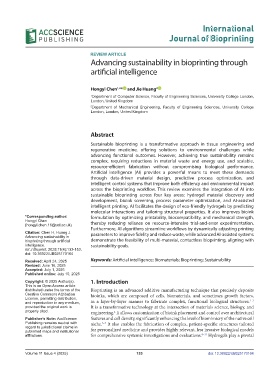Page 141 - v11i4
P. 141
International
Journal of Bioprinting
REVIEW ARTICLE
Advancing sustainability in bioprinting through
artificial intelligence
Hongyi Chen * and Jie Huang 2 id
1,2 id
1 Department of Computer Science, Faculty of Engineering Sciences, University College London,
London, United Kingdom
2 Department of Mechanical Engineering, Faculty of Engineering Sciences, University College
London, London, United Kingdom
Abstract
Sustainable bioprinting is a transformative approach in tissue engineering and
regenerative medicine, offering solutions to environmental challenges while
advancing functional outcomes. However, achieving true sustainability remains
complex, requiring reductions in material waste and energy use, and scalable,
resource-efficient fabrication without compromising biological performance.
Artificial intelligence (AI) provides a powerful means to meet these demands
through data-driven material design, predictive process optimization, and
intelligent control systems that improve both efficiency and environmental impact
across the bioprinting workflow. This review examines the integration of AI into
sustainable bioprinting across four key areas: hydrogel material discovery and
development, bioink screening, process parameter optimization, and AI-assisted
intelligent printing. AI facilitates the design of eco-friendly hydrogels by predicting
molecular interactions and tailoring structural properties. It also improves bioink
*Corresponding author: formulation by optimizing printability, biocompatibility, and mechanical strength,
Hongyi Chen
(hongyi.chen.16@ucl.ac.uk) thereby reducing reliance on resource-intensive trial-and-error experimentation.
Furthermore, AI algorithms streamline workflows by dynamically adjusting printing
Citation: Chen H, Huang J. parameters to improve fidelity and reduce waste, while advanced AI-assisted systems
Advancing sustainability in
bioprinting through artificial demonstrate the feasibility of multi-material, contactless bioprinting, aligning with
intelligence. sustainability goals.
Int J Bioprint. 2025;11(4):133-153.
doi: 10.36922/IJB025170164
Received: April 24, 2025 Keywords: Artificial intelligence; Biomaterials; Bioprinting; Sustainability
Revised: June 16, 2025
Accepted: July 1, 2025
Published online: July 10, 2025
Copyright: © 2025 Author(s). 1. Introduction
This is an Open Access article
distributed under the terms of the Bioprinting is an advanced additive manufacturing technique that precisely deposits
Creative Commons Attribution bioinks, which are composed of cells, biomaterials, and sometimes growth factors,
License, permitting distribution,
1–3
and reproduction in any medium, in a layer-by-layer manner to fabricate complex, functional biological structures.
provided the original work is It is a transformative technology at the intersection of materials science, biology, and
properly cited. engineering. It allows customization of bioink placement and control over architectural
4
Publisher’s Note: AccScience features and cell density, significantly enhancing the level of biomimicry of the native cell
Publishing remains neutral with niche. It also enables the fabrication of complex, patient-specific structures tailored
5–7
regard to jurisdictional claims in
published maps and institutional for personalized medicine and provides highly relevant, less invasive biological models
affiliations. for comprehensive systemic investigations and evaluations. 8–11 Hydrogels play a pivotal
Volume 11 Issue 4 (2025) 133 doi: 10.36922/IJB025170164

